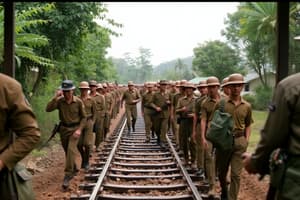Podcast
Questions and Answers
What types of tasks were carried out by the prisoners in Singapore?
What types of tasks were carried out by the prisoners in Singapore?
- Unloading ships and stacking merchandise (correct)
- Farming the local land
- Erecting bridges and roads
- Building residential homes
Where was a monument to the fallen warriors erected?
Where was a monument to the fallen warriors erected?
- Bukit Timah (correct)
- Changi
- Keppel Harbour
- Mersing
How did prisoners in Singapore feel about their work in the early stages?
How did prisoners in Singapore feel about their work in the early stages?
- They were indifferent to it.
- They felt it was a welcome distraction. (correct)
- They found it highly rewarding.
- They strongly resented it.
Which of the following locations is NOT mentioned as a site of Japanese prisoner camps in Singapore?
Which of the following locations is NOT mentioned as a site of Japanese prisoner camps in Singapore?
What was one of the reasons for the initial better conditions in the Singapore camps compared to other locations in Asia?
What was one of the reasons for the initial better conditions in the Singapore camps compared to other locations in Asia?
What construction project were prisoners involved in as the war progressed?
What construction project were prisoners involved in as the war progressed?
What was a significant drawback of the prisoners' work environment as the war continued?
What was a significant drawback of the prisoners' work environment as the war continued?
Which phrase best describes the overall labor conditions experienced by prisoners in Singapore compared to other Asian locations?
Which phrase best describes the overall labor conditions experienced by prisoners in Singapore compared to other Asian locations?
What was the significant event that occurred on 15 February 1942 in Singapore?
What was the significant event that occurred on 15 February 1942 in Singapore?
How many Australian troops were present in Singapore when it fell?
How many Australian troops were present in Singapore when it fell?
Where was the major POW camp established in Singapore?
Where was the major POW camp established in Singapore?
What role did Singapore play in the movement of POWs during the war?
What role did Singapore play in the movement of POWs during the war?
When did the distribution of prisoners from Changi across various work sites begin?
When did the distribution of prisoners from Changi across various work sites begin?
Which of the following locations was NOT mentioned as a destination for POWs moved from Singapore?
Which of the following locations was NOT mentioned as a destination for POWs moved from Singapore?
What was the approximate total number of British troops present in Singapore at the time of its fall?
What was the approximate total number of British troops present in Singapore at the time of its fall?
Which area was specifically mentioned as the eastern tip of Singapore where Changi was located?
Which area was specifically mentioned as the eastern tip of Singapore where Changi was located?
Flashcards are hidden until you start studying
Study Notes
Singapore POWs during World War II
- Singapore was a key internment location for Allied prisoners of the Japanese.
- Following its capture on 15 February 1942, over 100,000 British troops, including approximately 15,000 Australians, were present on the island.
- POWs were forced to march to Changi, the principal POW camp located at Selerang barracks.
- Singapore served as a transit hub, with many prisoners later moved to various sites in Borneo, Burma, Thailand, Japan, and beyond.
Work and Conditions of POWs
- From 22 February 1942, prisoners were allocated across multiple work sites on Singapore Island.
- Tasks included unloading ships at Keppel Harbour, stacking goods in warehouses, leveling bomb shelters, and collecting scrap iron for shipment to Japan.
- Approximately 2,800 POWs helped construct a monument for both Japanese and Allied fallen warriors at Bukit Timah.
Additional Activities and Camps
- Later in the war, POWs were involved in building an aerodrome and defensive systems in preparation for the anticipated Allied invasion.
- Various camp locations across Singapore included Great World, Adam Park, Bukit Timah, Sime Road, and others, many of which are still recognized today.
- Initially, work outside Changi was seen positively, offering a more open environment and opportunities for black market trading.
Changes in Conditions
- Despite initial better conditions compared to other Asian POW camps, the treatment involved an element of cruelty.
- As the war progressed unfavorably for the Japanese, food and water shortages became critical, impacting the wellbeing of POWs.
Studying That Suits You
Use AI to generate personalized quizzes and flashcards to suit your learning preferences.




